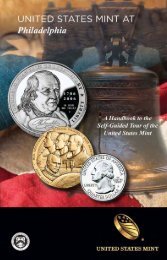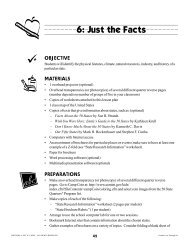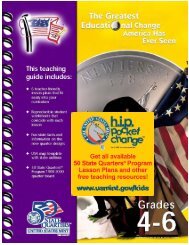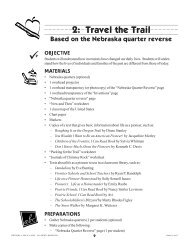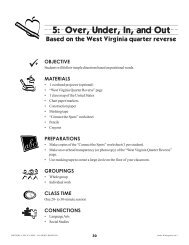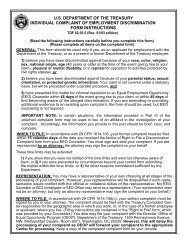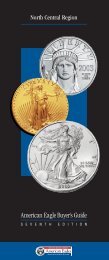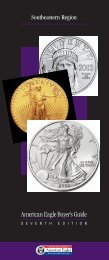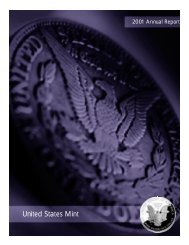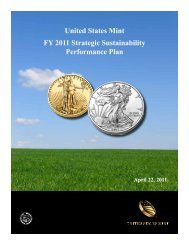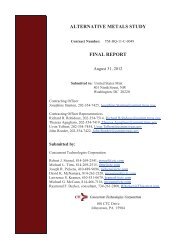2006 Nickel Lesson Plans, Kindergarten - The United States Mint
2006 Nickel Lesson Plans, Kindergarten - The United States Mint
2006 Nickel Lesson Plans, Kindergarten - The United States Mint
Create successful ePaper yourself
Turn your PDF publications into a flip-book with our unique Google optimized e-Paper software.
Let’s Build a Map<br />
<strong>Kindergarten</strong><br />
OBJECTIVES<br />
Students will gain an understanding of maps while studying the map of the Louisiana Purchase<br />
and the trail of Lewis and Clark and the Corps of Discovery. Students will demonstrate<br />
understanding of maps by creating a basic classroom map. Students will demonstrate an<br />
understanding of certain historical figures in <strong>United</strong> <strong>States</strong> history.<br />
CLASS TIME<br />
Four 20- to 30-minute sessions<br />
NATIONAL STANDARDS<br />
This lesson plan reflects some of the national standards of learning as defined by the National<br />
Council for the Social Studies (NCSS). <strong>The</strong>se standards are listed below:<br />
• Social Studies: Time, Change, and Continuity<br />
• Social Studies: People, Places, and Environment<br />
• Social Studies: Geography<br />
MATERIALS<br />
• Copies of the worksheets attached to this lesson plan (see “Preparations”)<br />
• 1 copy of the Westward Journey <strong>Nickel</strong> Series <strong>Lesson</strong> Plan Resource Guide (available<br />
at www.usmint.gov/kids)<br />
• 1 overhead projector<br />
• Blank overhead transparencies<br />
• Images of Lewis and Clark<br />
• Images of Monticello<br />
• 1 copy of a text that gives basic information about Lewis and Clark (see “Preparations”)<br />
• 1 copy of a text that gives basic information about maps (see “Preparations”)<br />
• Classroom map of the <strong>United</strong> <strong>States</strong> of America<br />
• Paper<br />
• Pencils<br />
• Butcher paper<br />
• Crayons<br />
• Scissors<br />
• Glue<br />
• White drawing paper<br />
PORTIONS © <strong>2006</strong> U.S. MINT. ALL RIGHTS RESERVED.<br />
1<br />
<strong>Kindergarten</strong>
Let’s Build a Map<br />
PREPARATIONS<br />
• Make copies of the following:<br />
– “Return to Monticello <strong>Nickel</strong> Reverse” (from the Resource Guide)<br />
– “Return to Monticello <strong>Nickel</strong> Obverse” (from the Resource Guide)<br />
– “What Happened Where” worksheet (1 per student)<br />
– “Things Found in the Classroom” worksheets (1 per group)<br />
• Make overhead transparencies of the following:<br />
– “Journey of Lewis and Clark Map” (from the Resource Guide)<br />
– “Westward Journey <strong>Nickel</strong> Series” worksheet (from the Resource Guide)<br />
– “Return to Monticello <strong>Nickel</strong> Reverse” (from the Resource Guide)<br />
– “Return to Monticello <strong>Nickel</strong> Obverse” (from the Resource Guide)<br />
– “What Happened Where” worksheet<br />
• Gather images of Lewis and Clark.<br />
• Locate a text that gives basic information about the Lewis and Clark Expedition, such as:<br />
– Lewis and Clark: Discover the Life Of An Explorer by Trish Kline<br />
– Lewis and Clark: Explorers of the American West by Steven Kroll<br />
– A Picture Book of Lewis and Clark by David Adler<br />
– Going Along with Lewis and Clark by Barbara Fifer<br />
• Locate a text that gives basic information about maps, such as:<br />
– Me on the Map by Joan Sweeney<br />
– Mapping Penny’s World by Loreen Leedy<br />
– <strong>The</strong>re’s a Map in My Lap! By Tish Rabe<br />
– My Map Book by Sara Fanelli<br />
• Mark off sections of the room that will be drawn in the map.<br />
• Divide the images from the “Things Found in the Classroom” worksheet into picture kits<br />
for each section of the room.<br />
GROUPINGS<br />
• Whole group<br />
• Pairs<br />
• Small groups<br />
PORTIONS © <strong>2006</strong> U.S. MINT. ALL RIGHTS RESERVED.<br />
2<br />
<strong>Kindergarten</strong>
Let’s Build a Map<br />
TERMS AND CONCEPTS<br />
• Obverse (front) • Reverse (back)<br />
• Thomas Jefferson • Keelboat<br />
• American Indians • Louisiana Purchase<br />
• <strong>Nickel</strong> • Lewis and Clark’s Corps of Discovery<br />
• Map<br />
BACKGROUND KNOWLEDGE<br />
Students should have a basic knowledge of:<br />
• Explorer<br />
• President<br />
STEPS<br />
Session 1<br />
1. Display an image of Meriwether Lewis and William Clark and explain that these men are<br />
important to our country’s history. Ask the students to brainstorm ideas about what these<br />
men may have done.<br />
2. Engage the students in a discussion about the meaning of the term “explorers,” directing<br />
them to realize that an explorer is a person who goes to a new place to find new things.<br />
Have the students brainstorm the names of other explorers with whom they may be<br />
familiar, such as Christopher Columbus.<br />
3. Display the “Journey of Lewis and Clark Map” overhead transparency. Note the Louisiana<br />
Territory and its position in relation to your school’s location. Explain to the class that<br />
Lewis and Clark were soldiers who led a group that called itself the Corps of Discovery.<br />
<strong>The</strong> Corps explored part of an area called Louisiana, which had recently been acquired by<br />
the <strong>United</strong> <strong>States</strong>. Explain that Lewis and Clark saw new things that they recorded in their<br />
journals, as well as collected samples to bring back to President Jefferson. Explain that<br />
Lewis and Clark were looking for a water route across the continent to the Pacific Ocean.<br />
<strong>The</strong>y also created a series of maps showing the route of their journey.<br />
4. Introduce the students to the selected text about Lewis and Clark. As a group, preview<br />
the text and illustrations to generate predictions about what will occur in different parts of<br />
the text.<br />
5. Read the text aloud. During the reading, refer to the “Journey of Lewis and Clark Map”<br />
and to follow along the route with the text. Attend to unfamiliar vocabulary and concepts.<br />
6. Display the “Return to Monticello <strong>Nickel</strong> Obverse” overhead transparency. Explain to the<br />
students that the man in the image is President Thomas Jefferson. He was the president at<br />
PORTIONS © <strong>2006</strong> U.S. MINT. ALL RIGHTS RESERVED.<br />
3<br />
<strong>Kindergarten</strong>
Let’s Build a Map<br />
the time of the Lewis and Clark Expedition and he was the man who sent the Corps of<br />
Discovery on their journey.<br />
7. Display the “Westward Journey <strong>Nickel</strong> Series” overhead transparency. Discuss the details<br />
of the images with the students. Tell them that these images represent key parts of the<br />
Lewis and Clark Expedition.<br />
8. Display the “What Happened Where” overhead transparency. Explain to the students<br />
that they are now going to put the important events from the coins onto their own map of<br />
the Louisiana Territory. Distribute a “What Happened Where” page to each of the<br />
students. As a class, work towards placing the coin images onto the important places on<br />
the map. <strong>The</strong> students may color their maps when they are finished.<br />
Sessions 2 and 3<br />
1. Review the text and the map from the previous session. Display the “Return to Monticello<br />
<strong>Nickel</strong> Reverse” overhead transparency. Ask the students what they see in the image.<br />
Explain to them that this is Monticello, the home of Thomas Jefferson, and Monticello is<br />
located in Virginia. Point out its location on the classroom map. Display your images of<br />
Monticello. Review that Thomas Jefferson sent the Corps of Discovery and that when<br />
they brought back things from their journey (like animal horns and skins, objects made by<br />
American Indians, and plants), Jefferson displayed some of them at Monticello.<br />
2. Compare the “Journey of Lewis and Clark Map” to the classroom map of the <strong>United</strong><br />
<strong>States</strong>. Discuss the similarities and differences between these maps, pointing out that they<br />
are of the same place although they look different. Explain to the students that the same<br />
thing was true of the maps Clark drew. <strong>The</strong>y used different ways of showing things but<br />
they represented the same places. Also, Clark had to make many small maps because of<br />
the size of his journal paper, and the maps were later combined to make a larger map of<br />
the whole journey.<br />
3. Introduce the students to the selected text about maps. As a group, preview the text and<br />
illustrations to generate predictions about what will occur in different parts of the text.<br />
4. Read the text aloud. During the reading, attend to unfamiliar vocabulary and concepts.<br />
5. Discuss the importance of maps and their uses.<br />
6. Explain to the students that they will be creating a map of their classroom. Discuss what<br />
things may be important to include in the map.<br />
7. Divide the class into small groups. Each small group will be assigned a part of the room to<br />
replicate on their map using their picture kits. Tell the students that there are empty<br />
squares in which they can draw things from their part of the classroom that they do not<br />
have a picture of. Explain that the class will put their maps together to create a bigger<br />
classroom map, as Clark had done.<br />
8. Model a sample map of something in the classroom (such as the teacher’s desk and chair).<br />
9. Allow an appropriate amount of time for the students to complete the activity.<br />
PORTIONS © <strong>2006</strong> U.S. MINT. ALL RIGHTS RESERVED.<br />
4<br />
<strong>Kindergarten</strong>
Let’s Build a Map<br />
Session 4<br />
1. Review the students’ maps from the previous session. Tell them that now they are going to<br />
work as a class to put all of those smaller maps together to create a complete map of the<br />
classroom. Explain to them that this is like putting a puzzle together.<br />
2. As a class, determine the location of each smaller map on the large butcher paper. Direct<br />
each group to place their map onto the butcher paper.<br />
3. Allow an appropriate amount of time to complete the activity.<br />
4. Discuss as a class why this map would be helpful to future visitors to their classroom.<br />
Relate this to the importance of Lewis and Clark’s map to future Americans and travelers.<br />
5. Display the map appropriately in the classroom or in the hallway.<br />
ASSESSMENT<br />
• Take anecdotal notes about the students’ ability to meet the lesson objectives.<br />
• Use the student maps to evaluate the students’ ability to appropriately represent objects in<br />
the classroom.<br />
ENRICHMENTS/EXTENSIONS<br />
• Have students create “discovery” questions leading to items to find in the classroom.<br />
Invite visitors in to use the map to locate the items on the list.<br />
• Have students create a similar map of somewhere outside of the classroom (such as their<br />
bedroom, their home, or a restaurant) and share these maps with the class.<br />
• Have students create a three-dimensional map of a favorite place.<br />
DIFFERENTIATED LEARNING OPTION<br />
Have students use partially completed maps and use provided pictures to complete their<br />
maps.<br />
PORTIONS © <strong>2006</strong> U.S. MINT. ALL RIGHTS RESERVED.<br />
5<br />
<strong>Kindergarten</strong>
Things Found in the Classroom<br />
Page 1<br />
PORTIONS © <strong>2006</strong> U.S. MINT. ALL RIGHTS RESERVED.<br />
6<br />
<strong>Kindergarten</strong>
Things Found in the Classroom<br />
Page 2<br />
PORTIONS © <strong>2006</strong> U.S. MINT. ALL RIGHTS RESERVED.<br />
7<br />
<strong>Kindergarten</strong>
What Happened Where<br />
Directions: Cut out the nickel images of events from the<br />
Lewis and Clark Expedition and place each one on the star<br />
where the event happened.<br />
PORTIONS © <strong>2006</strong> U.S. MINT. ALL RIGHTS RESERVED.<br />
8<br />
<strong>Kindergarten</strong>



